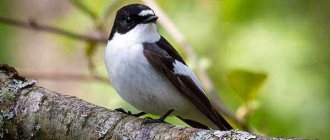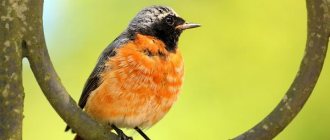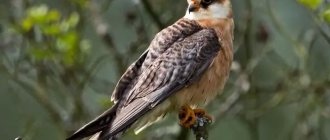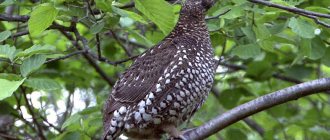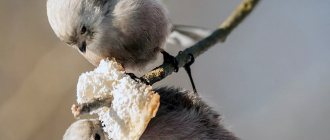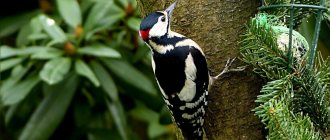Description of the blue jay
Blue jays are very beautiful birds, the main decoration of which is their long bright blue crests. The tail is also long. The beak is strong, with which jays can easily crack hard-shelled seeds. The color of males and females is the same, but the males are slightly larger.
The body length of the blue jay ranges from 25 to 29 centimeters, the wingspan is 34-43 centimeters, and the tail length reaches 13 centimeters. Weight ranges from 70 to 100 grams. Jays living in the northern parts of their range are larger.
North American jays have bright blue plumage. The crest is bright blue or blue-violet, the beak is black, and there is a black ring around the eyes. The feathers under the crest are black. The throat and entire underside of the body are gray-white.
The bridle is black and the cheeks are white. The tail and flight feathers are blue with transverse black stripes. There are white spots on the wings and tail. The edges of the tail are white. The eyes and paws are dark. The feathers of jays are not truly blue; this effect is achieved due to the distortion of light in the internal structure of the feather, and this effect disappears with torn feathers.
The blue jay is a songbird from the corvid family.
New abilities
If a jay lives for some time somewhere in the presence of a person engaged in agriculture, a person who finds himself in the forest, to his own surprise, may hear sounds that have nothing to do with the forest itself: the bleating of a sheep or goat, even the meowing of a kitten.
The sheer variety of sounds that a mockingjay can successfully imitate allows it to quite realistically portray:
- the ringing of a small bell;
- whistling any melody;
- falcon cry.
Lifestyle of North American Jays
Blue jays are intelligent and cunning birds.
If a jay detects danger, it screams loudly, informing other birds and animals about the threat. Often jays form groups and attack predators.
Jays living in the northern parts of their range migrate south, but some individuals may remain in place in winter. Jays migrate during daylight hours. They travel in groups of 5-50 individuals, but sometimes gather in larger flocks of about 300 birds.
Blue jays live in pairs or small family groups.
Young birds' first molt occurs in late summer, while adult jays molt from July to September. During the molting process, jays often bathe in anthills and collect these insects under their wings. It is believed that jays use ant bites to soothe itchy skin as their feathers grow.
Crested jays are quite social birds.
Blue jays live in family groups, pairs, or small flocks. They communicate with each other using body language; for this they use crests. If the jay is worried or in a state of aggression, then the jay's crest becomes vertical; when it is surprised, the jay's crest moves forward; when frightened, the jay's crest resembles a brush.
Blue jays lead a monogamous lifestyle.
Blue jays make a large number of sounds: they imitate the calls of a hawk, ring like bells, whistle melodiously, scream loudly, warning of danger, representatives of the pair communicate with each other using creaking sounds. Jays are excellent imitators; in captivity they can be easily trained to imitate human speech.
Crested owls' enemies are owls and falcons. Their life expectancy in nature is 10-18 years.
Migratory or not?
To say that the blue jay is a migratory bird is only half true. In the cold season, only the most northern populations, migrating to the south, decide to change their place of residence.
Having gathered in a large flock, they move south, waiting for the warmth to come again. Those who are not susceptible to changing their place of residence remain in their native lands for the winter. Knowing that they are not in danger of leaving their homes, they diligently stock up on food for the winter. They prefer to store food buried in the ground or under fallen leaves, and sometimes in the bark of trees.
For example, the diet of collected acorns for the winter for one individual can be up to 5,000 pieces. While creating food reserves for themselves, they do not forget to drive away all those who are not at all averse to profiting at their expense. They can fearlessly argue with woodpeckers, starlings, and even particularly curious squirrels.
Among other things, the jay has a simply unique ability to remember certain things. In particular, they perfectly remember all their hidden food reserves, most of which are usually acorns, seeds and berries.
Blue jays feeding
Blue jays are omnivorous birds. They can feed on plant foods, for example, beech nuts, acorns, berries, seeds, fruits, and animal foods: grasshoppers, spiders, beetles, centipedes, frogs, lizards, chicks, mice, bird eggs. In addition, they can eat carrion.
The blue jay is an intelligent, cunning and treacherous bird.
Each jay can prepare 3-5 thousand acorns in the fall.
Plant foods make up 78% of the blue jay's diet, while 22% comes from insects and small vertebrates. Often jays steal prey from other birds. Non-migrating jays prepare supplies for the winter, for example, collecting seeds, acorns and hiding them under the bark of trees or burying them in foliage and soil. A jay is capable of carrying 5 acorns at a time: it holds 1 in its beak, another 1 in its mouth and 2-3 in its crop.
Food competitors of crested jays include woodpeckers, scrub jays, Florida jays, gray squirrels, and starlings. Sometimes jays imitate hawks to ward off other birds from eating, but most often the birds quickly return back as soon as the jays start eating.
Miniature bird
The size of this bright bird rarely exceeds 30 cm, just as its weight rarely exceeds 100 grams. Males are quite significantly ahead in size of their companions, but still remain within these limits.
A talented bird can quickly not only get used to new sounds, but also reproduce them very similarly. It is not for nothing that the bird has earned an addition to its name - it is also called the mockingbird.
Reproduction of blue jays
The breeding season of North American jays in the northern part of their range occurs once a year and occurs in May-June, and in the south jays breed twice.
Jays begin to form pairs with the beginning of the first sunny days, after which they build nests. They make nests in the forks of branches of coniferous or deciduous trees. The nests are located at a height of 3-10 meters above the ground. Both parents are engaged in construction. The outer part of the nest is made of twigs, and the inner part is lined with roots, wool, rags, clay and earth. The diameter of the nest can reach 20 centimeters, and its height reaches 10 centimeters.
The blue jay is only partly a migratory bird.
Before building the main nest, jays build several partial nests as part of ritual courtship. In addition, males, while courting females, feed their chosen ones. The female flies up to the male and assumes the pose of a chick, who asks for food, in response the male feeds her.
If a predator finds the nest, the blue jays may abandon it forever. Jays are loud, but become quiet during the breeding season. The clutch of a crested jay contains 2-7 eggs that are bluish or yellow-green in color with brown spots. The female does the incubation; the incubation period is 16-18 days.
The blue jay is a very beautiful bird with a long bright blue crest.
The chicks are blind and completely dependent on their parents. The female and male feed them, clean them, warm them and take care of their safety. The chicks' eyes open on the 5th day, and feathers appear on the 8th day.
When the chicks are about 12 days old, the female begins to fly out of the nest and look for food. A few days before departure, the chicks begin to crawl along neighboring branches, but do not move further than 4.5 meters from the nest. At 17-21 days they fly out of the nest. At first they circle not far from their parents' house. They stay close to their parents until autumn, but in winter they begin to live independently.
Sometimes jays imitate hawks to deceive other birds and drive them away from food.
Character
The charming representative of this species does not have a complex, but still restless character. And caution is almost an innate quality. The jay is able to notice a certain threat from afar and warn others about it. It's not scary together.
Even if we are talking about attacking an uninvited guest. Gathered in a small flock, the jays fearlessly rush at their enemy and try to peck him, if not to death, then to ensure that he swears off sticking his nose into their domain in the future.
The benefits and harms of blue jays for people
Jays destroy harmful insects, for example, forest pests such as longhorned beetles, chafers, caterpillars, weevils, and the like. Blue jays are easily tamed and do well in captivity. But these birds are aggressive, so they cannot be kept with other birds.
The blue jay is omnivorous.
Crested jays are the mascot of many sports teams, including the Toronto Blue Jays, a professional basketball team. Every year, jays destroy a large number of nests of small birds, they kill chicks and eat eggs. But they are useful by spreading acorns and seeds.
The most charming representatives of the species
The black-headed blue jay is deservedly considered the most beautiful in the entire family. Representatives of this species mainly live in the mountains and coniferous groves of North America. Only in the cold season, when the amount of snow in the mountains increases significantly, do representatives of the species move to the plain.
Another fascinating species is the Scrub Blue Jay. This species is on the verge of extinction. Its representatives live in the state of Florida on the Gulf Coast, and frequent forest fires do not contribute to their reproduction.
Blue jay population
Jays are quite abundant throughout their range. Today there are 4 subspecies of blue jays:
- C. c. cyanotephra are distributed in Nebraska, Wyoming, Kansas, Colorado, Texas and Oklahoma;
- C. c. bromia live in Newfoundland, North Dakota, Northern Canada, USA, Missouri and Nebraska;
- C. c. samplei are found in northern Florida;
- C. c. cristata are found in Kentucky, Missouri, Virginia, Tennessee, Illinois, Florida, Texas and North Carolina.
If you find an error, please select a piece of text and press Ctrl+Enter.
Reasons for frequent fights with competitors
Any jay, no matter how fearless it is, can become prey to a larger predator. There are 2 main reasons for this:
- The jay does not fly very fast, and can give way even to an owl, not to mention a hawk.
- The jay is incapable of retreat and always fearlessly confronts any larger enemy, never trying to escape from them.
But jay nests, often left unprotected by adult representatives, are an object of interest for crows, snakes, squirrels and even cats.
